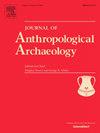Wetlands and grasslands: Habitat choice of hunters and herders across the transition to mobile pastoralism in Mongolia’s desert-steppe
IF 2.2
1区 社会学
Q1 ANTHROPOLOGY
引用次数: 0
Abstract
This paper presents the results of a study that investigates the settlement history of Mongolia’s desert-steppe to understand the role of foragers in the evolution of pastoralism. The study examines land use, mobility, technological organization, and environmental context prior to, during, and after the transition to food production (Neolithic-Kitan Periods, ca. 6050 BCE-1150 CE) to detect differences in how, when, and why people moved, illuminating how people make decisions about existing environments. Employing frameworks of habitat suitability and behavioral optimization, this study documents important shifts in land use and mobility across the Neolithic-Bronze Age transition (ca. 2550 BCE) as people began to take up herding. Settlement and population patterns indicate a pronounced change in habitat choice across this transition, suggesting that preferences of committed herding societies (Iron Age and beyond) were firmly established during the Bronze Age as people began to prioritize upland grasslands and productive wintertime vegetation. This shift coincided with the onset of dry, cool conditions, a reversal of wetter, cool environments where prior foragers targeted a broad range of habitats, including wetlands. These patterns set the stage for adaptations that came to define mobile pastoralism across Eurasia including high residential mobility, long distance connections, social differentiation, and broadly adopted mortuary traditions.
湿地和草原:蒙古沙漠草原向流动畜牧业过渡过程中猎人和牧民的栖息地选择
本文介绍了一项研究的结果,该研究调查了蒙古荒漠草原的定居历史,以了解觅食者在畜牧业演变中的作用。该研究考察了土地利用、流动性、技术组织和环境背景,在向粮食生产过渡之前、期间和之后(新石器时代-契丹时期,公元前6050年-公元前1150年),以检测人们如何、何时以及为什么移动的差异,阐明了人们如何对现有环境做出决定。采用栖息地适宜性和行为优化框架,本研究记录了新石器时代至青铜时代(公元前2550年左右)人类开始从事放牧时土地利用和流动性的重要转变。定居和人口模式表明,在这一转变过程中,人类对栖息地的选择发生了显著变化,这表明,在青铜时代,人们开始优先考虑高地草原和多产的冬季植被,从而坚定地确立了忠诚的放牧社会(铁器时代及以后)的偏好。这一转变与干燥、凉爽环境的开始相吻合,这与以前觅食者瞄准包括湿地在内的广泛栖息地的潮湿、凉爽环境的逆转。这些模式为适应奠定了基础,这些适应后来定义了欧亚大陆的流动畜牧业,包括高居住流动性、远距离联系、社会分化和广泛采用的殡葬传统。
本文章由计算机程序翻译,如有差异,请以英文原文为准。
求助全文
约1分钟内获得全文
求助全文
来源期刊

Journal of Anthropological Archaeology
Multiple-
CiteScore
4.00
自引率
11.10%
发文量
64
期刊介绍:
An innovative, international publication, the Journal of Anthropological Archaeology is devoted to the development of theory and, in a broad sense, methodology for the systematic and rigorous understanding of the organization, operation, and evolution of human societies. The discipline served by the journal is characterized by its goals and approach, not by geographical or temporal bounds. The data utilized or treated range from the earliest archaeological evidence for the emergence of human culture to historically documented societies and the contemporary observations of the ethnographer, ethnoarchaeologist, sociologist, or geographer. These subjects appear in the journal as examples of cultural organization, operation, and evolution, not as specific historical phenomena.
 求助内容:
求助内容: 应助结果提醒方式:
应助结果提醒方式:


